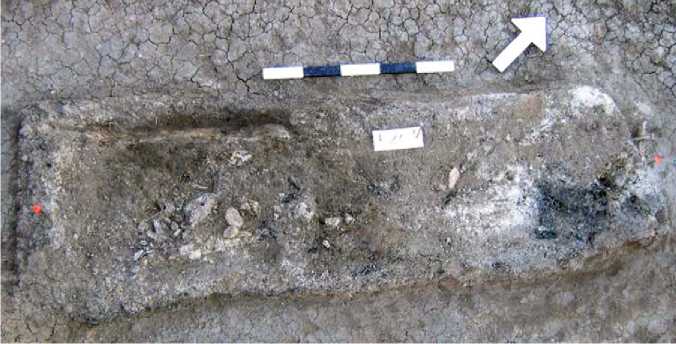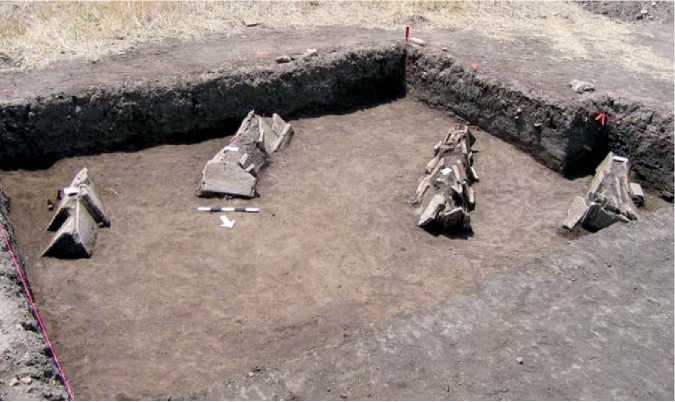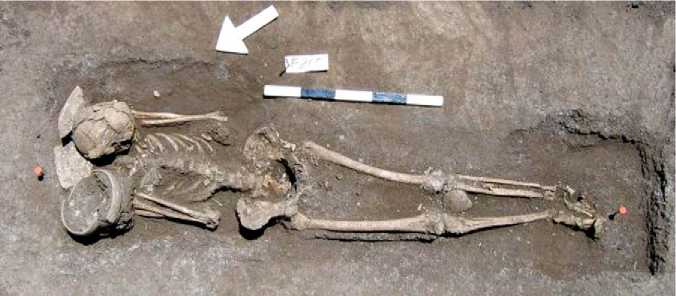Proper excavation of a burial requires time; it must be done carefully and methodically. The objective is to completely expose the skeleton and all associated artifacts, while minimizing damage to the skeleton by extended exposure to the elements. It is essential to have an osteologist as a member of a burial excavation project from the early planning stages, particularly when dealing with complex multiple burials or infant and subadult skeletons. At the very least, excavators should have thorough osteological training so they can quickly and accurately identify bones as they are being uncovered. Whether excavating a single burial or multiple burials in a cemetery, the main priority is to maximize the amount of information obtained, because once the burial is excavated its original context is lost. Proper recording of all stages of excavation is crucial for accurate interpretation of the results. The entire site should initially be surveyed using a ‘total station’ or ‘transit’, which maps the location of the site and each individual feature on the site in relation to a chosen reference point, or ‘datum’.
When excavating a single burial, the first step is to determine the limits of the burial. Clearing soil from above the burial can be done with picks and shovels. Heavy machinery can be used under certain conditions, particularly when excavating cemeteries that require large surface areas to be exposed. Excavation using heavy machinery must proceed slowly in order to watch for the first traces of burials in the ground. Opening up a relatively large area in a cemetery excavation may help to delineate spatial relationships between the burials (Figure 2). There may be an obvious burial structure to expose, but if there is none then the archaeologist should look for evidence of a burial outline through localized changes in soil color or consistency. All aspects of the burial should be recorded before the skeleton is exposed, including dimensions, orientation, depth from surface, and distance from the datum (measured at both ends of the burial). The burial should be mapped on a scale drawing and photographed using both digital and

Figure 1 Cremation burial showing evidence of burning (black) and cremated bone.

Figure 2 Cemetery excavation with all of the burials exposed in a trench, so that the orientation of the burials and their spatial relationships can be documented.
SLR (single-lens reflex) cameras (see Burials: Dietary Sampling Methods; Osteological Methods).
If excavating a cemetery, the number of burials opened up at any given time should be determined by the number of excavators available. Partially or fully excavated skeletons should not be left exposed for extended periods of time, so each burial should be fully excavated and removed by one team before another burial is started. Exposure of the skeleton should proceed by carefully removing soil in horizontal layers across the entire surface of the burial. As the bones are encountered, they should not be completely exposed until the location of all the bones has been determined, so that the excavator has an idea of the orientation and position of the skeleton. The characteristics of the soil inside the burial should be recorded and any material found in the burial fill should be recorded separately from material found outside the burial. Excavation tools should include smaller tools such as trowels, brushes of various sizes, bamboo skewers, wood sculpting tools, small spoons, and dental picks. Dental picks are useful tools because they are strong and can be used for fine work, but they can easily damage the skeleton so it is best to use less destructive tools like wood carving tools, skewers, and brushes when clearing soil adhering to the bones. If the skeleton is going to be sampled for biochemical or ancient DNA analysis, the bones should be handled as little as possible and ideally surgical gloves should be worn when touching the bones.
It is best to work from the center of the skeleton outward, so that exposed bones are not covered with dirt from the middle of the burial. Hands and feet should be excavated last, because they are easily disturbed once exposed. All the soil inside the burial should be screened for small artifacts, teeth, and other small finds. The entire skeleton and any associated grave goods should be exposed, so that the position of the artifacts in relation to the skeleton can be recorded. As excavation proceeds, the skeleton should be protected as much as possible from extended exposure to the elements, as this can damage the bones. All of the dirt around the bones should be cleared, so that the bones are clearly visible for photography and drawing. Soil samples should also be taken from inside any vessels for ‘flotation’ analysis.
Once the skeleton and associated artifacts are completely exposed, they should be drawn and photographed in situ. All photographs should include a label, a scale, and a North arrow in the image (Figure 3). The area surrounding the skeleton should be cleared of any tools, equipment, and loose soil before the photograph is taken. A series of photographs from a variety of angles and distances should be taken; never rely on only one photograph. Detailed information about the position and orientation of the skeleton should be recorded. Standard terms used to describe the position of the skeletal elements include: ‘extended’, indicating that the legs are at 180° in relation to the ‘axial skeleton’; ‘semi-flexed’, indicating that the angle of the legs is between 90° and 180° to the axial skeleton; and ‘flexed’, indicating an angle of less than 90°. In addition, the position of the arms should also be recorded (e. g., at the sides, crossed at the chest or pelvis, etc.). The position of the skeleton (on its back, front, or laying to one side), the orientation of the main axis, maximum length and width, as well as depth from surface (at the cranium and feet) should also be recorded (Figure 4). Dimensions of the


Figure 4 Measuring the location of skeletal elements in a burial using a plumb bob and measuring tape. Note the use of an umbrella to protect the burial from the sun.
Excavated burial pit and distance from the datum should be measured. The exact position of each object in the relation to the skeleton should be described, measured, photographed, and recorded. Standard forms can be used to collectively record all of this information, but written observations should still be recorded.
Once the burial has been extensively recorded, removal of the skeleton and associated artifacts can take place. If the bones are extremely fragile, it may be necessary to consolidate the bones in situ before attempting removal. Any type of ‘consolidant’ used should be soluble, so it can be removed at a later date if required. Further soil may have to be excavated from underneath the bones in order to remove them; they should never be forcibly extracted from the ground. Label each bone as it is removed (e. g., right femur, left femur), and keep paired bones in separate containers. Right and left sides of the ribs, hands, and feet should be stored separately. The soil in the pelvic region should be carefully examined and screened for the presence of fetal skeletal remains, kidney stones, or possible traces of intestinal parasites. The cranium should be removed with care and the surrounding soil should be examined for loose teeth or other small bones, like the bones of the inner ear. Once all material has been removed, screen the remaining soil in the burial to recover any small bones or bone fragments.
There are a variety of materials recommended to transport and store skeletal material, including aluminum foil, acid-free paper, and paper, cloth, or plastic bags. Regardless of the material used to transport the material back to the field house or laboratory, label each bone or bone assemblage with the site name, burial number, skeletal element(s) and date. All the bones should be laid out in a protected, shaded area for cleaning and should be allowed to dry completely. Long-term storage of skeletal material and artifacts should be in labeled containers that are suitable for fragile material and that will not deteriorate over time. Proper excavation, documentation, and conservation of burials and their contents will ensure that we obtain the most evidence from these invaluable sources of information about our past.
See also: Burials: Dietary Sampling Methods; Osteolo-gical Methods; Remote Sensing Approaches: Aerial; Remote Sensing Approaches: Geophysical.




 World History
World History









